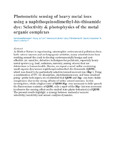| dc.description.abstract | As Mother Nature is experiencing catastrophic environmental pollutions from both natural sources and anthropogenic activities, many scientists have been working around the clock to develop environmentally benign and cost-effective, yet sensitive, detection techniques for pollutants, especially heavy metal species (e.g. lead, cadmium, mercury, among others) that are deleterious to human health. Herein, we report a novel sulfur-containing small organic dye/sensor naphthoquinodimethyl-bis-thioamide (QDM), which was found to be particularly selective toward mercury ion (Hg2+). Using a combination of UV–vis absorption, photoluminescence, and time-resolved pump–probe techniques, we established that QDM and Hg2+ can form stable complex(es) due to the strong affinity of sulfur toward mercury. In this investigation, while a higher ratio of QDM:Hg2+ was necessary to fully quench the fluorescence emission of QDM, only 1 equiv of the Hg2+ ion was necessary to observe the sensing effect on the excited state photo-behavior(s) of QDM. The present results highlight a synergy between molecular sensors’ selectivity/sensitivity and sensor-analytes dynamics. | en_US |

